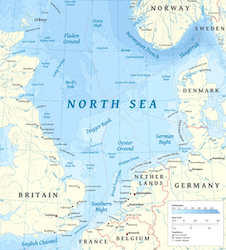
North Sea. A epeiric sea that lies between Great Britain, Denmark, Norway, Germany, the Netherlands, Belgium and France. It connects to the Atlantic Ocean through the English Channel in the south and the Norwegian Sea in the north. It is more than 600 miles (970 km) long and 360 miles (580 kilometers km) wide.
It hosts key north European shipping lanes and is a major fishery. The coast is a popular destination for recreation and tourism in bordering countries, and a rich source of energy resources, including wind and wave power.
The North Sea has featured prominently in geopolitical and military affairs, particularly in Northern Europe, from the Middle Ages to the modern era. It was also important globally through the power northern Europeans projected worldwide during much of the Middle Ages and into the modern era.
The North Sea was the center of the Vikings‘ rise. The Hanseatic League, the Dutch Republic, and the British each sought to gain command of the North Sea and access to the world’s markets and resources. As Germany’s only outlet to the ocean, the North Sea was strategically important through both world wars.
The coast has diverse geology and geography. In the north, deep fjords and sheer cliffs mark much of its Norwegian and Scottish coastlines respectively, whereas in the south, the coast consists mainly of sandy beaches, estuaries of long rivers and wide mudflats.
Due to the dense population, heavy industrialization, and intense use of the sea and the area surrounding it, various environmental issues affect the sea’s ecosystems. Adverse environmental issues – commonly including overfishing, industrial and agricultural runoff, dredging, and dumping, among others – have led to several efforts to prevent degradation and to safeguard long-term economic benefits.